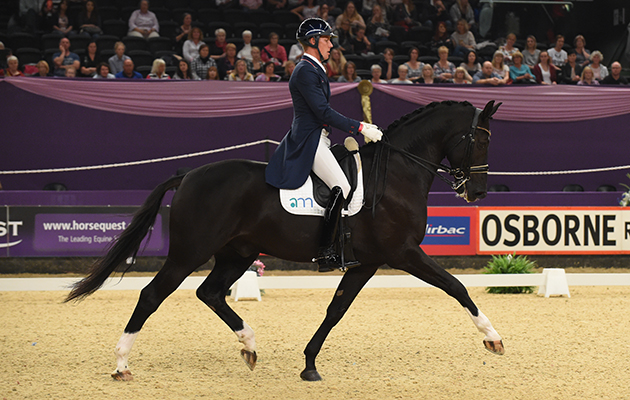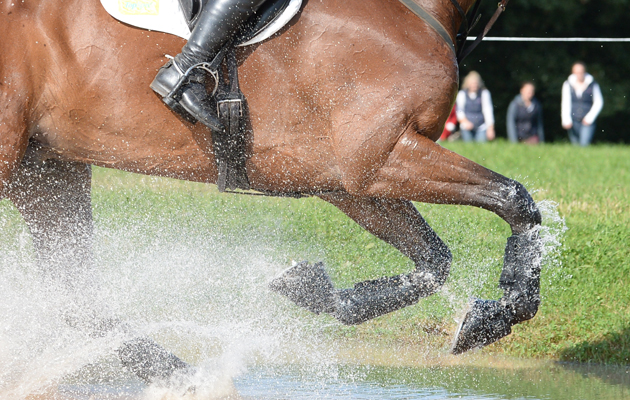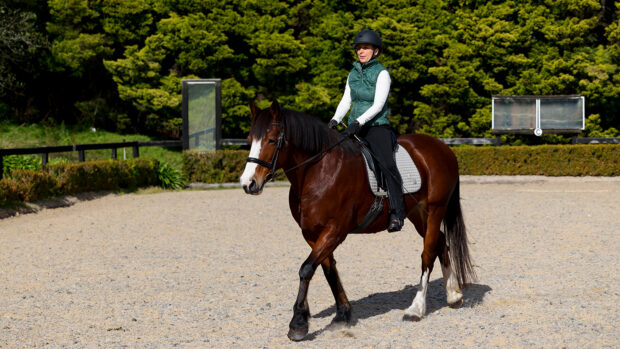Sport psychologist Inga Wolframm — who specialises in equestrian sports and offers advice across the disciplines — gives her 10 top pieces of advice for success on competition day.
1. Know your level
Ideally, at home you should be training a couple of levels above the one you’re planning to compete at. Why? Because it gives you confidence. A competition is stressful enough without the additional worry of whether you and your horse are able to pull off all the movements in a test or cope with the height/technical requirements of a course. If you can be sure though that the demands of the competition are well within your capabilities, you’ll be that much more relaxed before you start.
2. Know yourself
Do you prefer to arrive at the show ground with plenty of time to familiarise yourself with your surroundings, walk around a little, have a cup of coffee – or does waiting drive you crazy and you’d rather just get on and get started? Plan your day according to what keeps you in the best frame of mind. If you’d rather leave the yard with a few hours to spare, do that. If you’re one to get there at the last minute, that’s fine too – just make sure you allow enough time for traffic. Not everyone’s the same, so don’t just copy what your friends do.
3. Plan ahead
Enough things can go wrong without your planning being one of them. So make sure you’ve got everything you need ready well before you leave. Think of things that might go wrong when you get there, such as the zip of your boot breaking or the weather changing just as you get there. While you can’t plan for every eventuality, having a “just in case” kit stored away in your car or trailer will give you additional peace of mind.
4. Distract yourself
Do you worry yourself silly about all the things that might go wrong in the ring? Can you picture everyone laughing their heads off at your poor performance? Are you convinced the judges hate your horse? Rest assured, these thoughts are normal, most riders experience them at one time or another. But they’re also unproductive and quite often end up undermining your performance. Rather than desperately trying not to think them, it’s best to simply try and accept that you do. After that, move on and find something to do to take your mind of those negative thoughts. Playing a game on your smart phone, gossiping with a friend, and, while on board, focusing on what you are going to do and breathing correctly can work wonders.
5. Ignore other people
I don’t mean all the time, of course. But while you’re on your horse, you shouldn’t be watching or paying attention to anyone else, be that fellow competitors, judges or spectators. You can’t control them anyway – not what they’re doing or thinking, nor what they’ll say to each other or how they’ll score your test. Incidentally, it’s not always a good idea to watch other competitors beforehand either. If you only end up comparing yourself unfavourably, you should leave it until after you’ve ridden.
6. Set yourself goals
The best way to stay “in the zone” is to know exactly what it is that you want to achieve and how you are going to go about it. You want to ride a quiet test? Focus on keeping your joints supple and your muscles relaxed and “off” the horse until you need to give an aid. You want to ride with more expression? Keep making sure your horse is “on” the aids. Most importantly – don’t just focus on these goals in your warm-up, but keep reminding yourself of what you want to do while in the ring too.
7. Breathe
Ever asked yourself how come you can ride for an hour at home without breaking a sweat, but a few minutes in the ring leave you completely knackered? It’s because you forgot to breathe. Many riders will hold their breath for long periods in the ring, and, when they finally do take a breath, inhale into their chest cavity. The problem is, this type of chest breathing is very closely linked to the “fight or flight response”. Breaths are short, shallow and jerky. Muscles are tight, tense and ready to jump into action – not ideal when you’re doing a sport that, first and foremost, depends on fine motor control. The answer? Learn to breathe into your belly, taking long, slow breaths. As you inhale, your belly should round a little, as if you’re blowing up a balloon. Once you exhale, your belly will shrink again. Some practice is required, especially if you’re not used to it. But in addition to relaxed muscles, you’ll also end up with a calmer mind. Focusing on breathing correctly, leaves little space in your head for any other worrying thoughts.
8. Be nice to yourself
Riders are possibly the most critical group of people I’ve ever come across. And that’s a good thing when you’re sitting on top of an animal with a mind of it’s own, you can’t afford to be complacent. But if being critical about yourself is all you do at a show, you’re missing the point. Too many riders keep telling themselves that they are “rubbish”, that they “don’t belong”, that they “might as well go home”. This kind of behaviour serves absolutely no purpose other than undermining your confidence. So try and be nice to yourself once in a while by complementing yourself: on a well-executed movement, your nicely turned out horse, or the planning with which you’ve entered the competition. And if you cannot bring yourself to come up with a compliment, at least think of something constructive to say.
9. Visualise
You might already be doing it without realising what it is – seeing yourself ride your test/course before you’re even on the horse. This is called imagery or visualisation and it’s one of the most powerful mental training techniques. Why? Because when you’re imagining yourself doing something, you are giving your brain a “blueprint” for the real action later on. The only catch is that you need to be in control of your mental images. The last thing you want is to see yourself making a mistake. By practising first with easy, non-threatening images – brushing your horse or mucking out – you’ll gain control over your mind and will soon be ready to move onto visualising yourself perform.
10. Enjoy it
You’ve trained, you’ve prepared, you’ve spent lots of money and put in oodles of time. This is your moment and so enjoy it.
You may also enjoy reading…
Victoria Brant, author of the blog 'Diary of a Wimpy Eventer', is on a mission to get her nerve back

Take a spare plaiting kit and other ways to stay calm ahead of a dressage test

6 reasons it’s okay to be a little bit nervous when you go eventing (you’re not alone)

Subscribe to Horse & Hound magazine today – and enjoy unlimited website access all year round
Horse & Hound magazine, out every Thursday, is packed with all the latest news and reports, as well as interviews, specials, nostalgia, vet and training advice. Find how you can enjoy the magazine delivered to your door every week, plus options to upgrade your subscription to access our online service that brings you breaking news and reports as well as other benefits.




